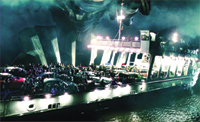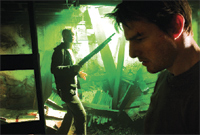SAN RAFAEL - With all the different versions of War of the Worlds over the past 107 years, there are a lot of reasons for director Steven Spielberg to want to visualize the most terrifying war machines ever to stride across a movie screen.
The ones stalking his new War of the Worlds, starring Tom Cruise, are arguably the most artistically realized. But there's no argument about size; at 150 feet tall these are the largest. (Except for the 18-inch posable model built for reference by ILM's John Goodson.)
First Spielberg's people gave George Lucas's art department written descriptions - no pictures or drawings to go by. Then ILM's visual effects art director, Christian Alzmann, started drawing on paper, as did ILM designer/concept artists Ryan Church and Eric Tiemens, until they had lots and lots of versions for review.

War of the Worlds' tripods were created in Softimage and Maya.
|
The "tripods" are alien war machines perched atop sets of three impossibly tall legs. The war machines have "big, bright, buggy eye-lights," lethal, articulate tentacles and weapons too. But one new tripod feature is unexpected: rust. The war machines look a little beaten-up and oxidized, Alzmann says, because they were buried in place eons ago, before modern man paved over the United States, waiting to be activated by their implacable alien masters.
ON DUTY START TO FINISH
ILM's award-winning VFX team, led by senior visual effects supervisor Dennis Muren and visual effects supervisor Pablo Helman, worked with Alzmann throughout the project's duration. And the duration was relatively short –- Spielberg himself eventually expressed wonderment that they completed the effects-heavy extravaganza in less than a year. "That was the real big trick this time, to get that speed," Alzmann says.
Initially, artists were shown only small sections of Spielberg's closely guarded script, but "we were real excited because it was such a great story," Alzmann says, "and we started designing these big machines, everybody taking stabs at some of the looks of the machines." Alzmann says that he, Church, Tiemens, Carlos Huante and Sang Jun Lee worked up numerous sketches and sent "really thick packets" of paper downstate to Spielberg and company. In conference calls, the director would tell the team which designs were working for him.

Both iView and CineSync were used for remote approvals.
|
To create these art prints, Alzmann's team would scan drawings into the computer for Photoshop retouching and Corel Painter. After a few weeks the artists got their approval and Alzmann could then nail down the look of the war machines and storyboard how they would behave in various action sequences to minimize any wasted effort on the CG side. "When this 150-foot-tall machine comes up out of the ground, we had to do a lot of design for that," he says. "What does that look like when pavement gets broken up on that scale?"
Alzmann kind of switches teams from the graphic artists to the CG artists: "Since we designed it, who better to make sure that the design gets followed through?"
Design approval means you must next get down to more real-world functional issues like "how is this thing going to move?" and "that joint needs to look like it really works." Randy Dutra was the animation supervisor on War.
"There was a real good connection between him and the art department," Alzmann says. Dutra was involved in designing how the long legs would join the war machine's body at the hip and how it would walk. "He got to influence the design because he's going to have to move this thing, and we influenced the animation because we were designing it. It was a really good team that way. Michael DiComo was the CG supervisor and when I'd design something difficult to do, he'd just work with it and get it done." Giovanni Nakpil modeled the tripod in CG. The CG team uses a mix of Alias Maya and Avid Softimage.
UNIQUE DEATH RAYS
The finished tripods offer a bit of homage to the original threat in H. G. Wells's classic story. But one feature that concerned Alzmann was perspective. "What do these things look like looking up at them from eye-level? The legs are so long, it's kind of a spooky daddy long legs, but they have the tentacles to come down and reach you."
Alzmann was also involved in battle action and worked on the look of the tripod's death rays, the tripod's defensive force field and more. ILM went for a kind of liquid-looking "plasma" ray and there are different rays for different jobs. (For instance, human victims "just turn into ash and blow away" once hit with the appropriate ray.) "You're thinking of the texture of the light at the edge of the beam; you're thinking of the color," Alzmann says - the rays have different stages of color.
Every day during the last month of production, ILM transmitted shots to studios where Spielberg was working. To make sure they kept getting the approvals, sometimes ILM would video conference at his home via the Mac's iView and transmit files over the Internet. "We have this other program called CineSync where they could download the files off a secure server and we could call him up and use the camera to talk to each other while watching the file."